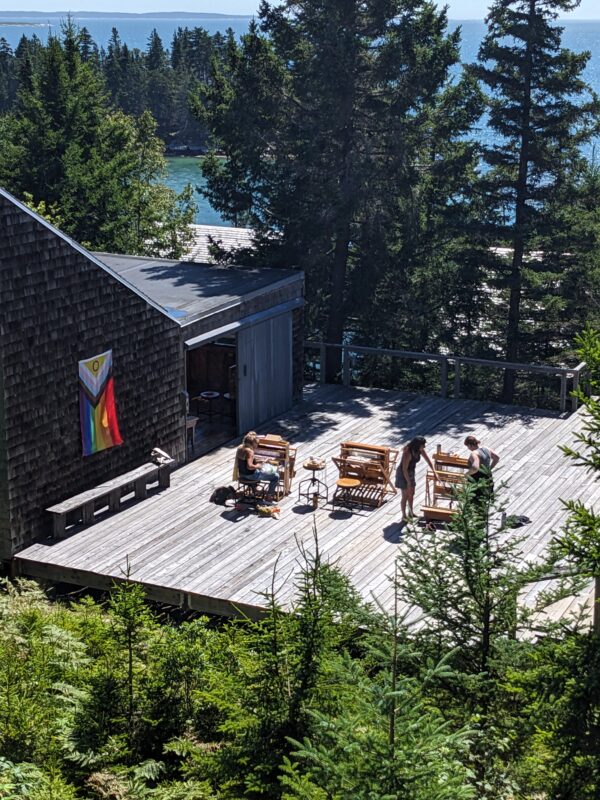At the end of August 2023, in the two glorious weeks before summer officially ends and everyone girds themselves for a bustling fall, I had the incredibly good fortune to be a visiting curator at Haystack Mountain School of Craft in Deer Isle, Maine. Occupying a writer’s hut on the campus, my goal was to leave with a chunk of my next book written—which just so happens to be on craft schools, so it was a perfect situation.
After mornings writing, I roamed the studios where students and teachers worked in meditative reverie in ceramics, wood, fiber, glass, graphics, metals, and in the Haystack Fab Lab.

Students weaving on floor looms on Haystack’s fiber studio deck. Photo Credit: Victoria Marcetti
Early in the session, the generous teacher in the fiber studio, University of Colorado at Boulder professor Steven Frost, and their incredible teaching assistant, Dr. S. Wu, set up a community loom. Chiming the gong in the dining hall one day early in our stay, they offered an open invitation to those gathered: Come add a few lines to the loom, no expertise necessary.
Wu set up the loom using black and white threads for the warp. That made it easier for beginners like me to see exactly what happened when each participant used the different floor pedals to separate the strings as they wriggled materials through. All the fibers woven into the communal tapestry were recycled, from the old, cut-up T-shirts that Frost brought with them to Haystack, to a woolen scarf they helped me chop into strips as my contribution. Others added their own embroidered sashiko denim, rows of flattened tea bags, and furry pink fabric braided with bristling pinecones.

Unveiling the community weaving along with the community loom. Teacher Steven Frost is in the yellow cap. Photo Credit: Victoria Marcetti
As a curator of contemporary craft, most of my energy is devoted to interpreting, contextualizing, and communicating the practices of artists with whom I work. I grew up in the Scottish Borders, a place steeped in textile history, yet I have never sat at a loom. Getting to learn not only how a floor loom operates, but to also experience the haptic, embodied process of choosing materials, considering color, and sitting in a busy classroom with students of all ages and stages learning to set up their own floor looms, was a way of deepening my writing practice. It was an opportunity I treasured. So, too, did many others during the session.
The end result was several meters long and was taken off the loom as the Session 5 community looked on and helped tie it off. Someone popped a champagne cork and handed out cups, a reminder that conviviality has always been the foundation of spaces like Haystack—in the mold of Black Mountain College and the Bauhaus before them, where play and experimentation were wholly adult artistic pursuits.
The result hung proudly in the Haystack gallery on the final evening before being welcomed into its permanent collection as an example of the community spirit of this special place. Shaunta Butler, one of the session’s Fab Lab resident artists, made anyone who asked, including me, their own CNC (computer numerical control) mini loom to make sure we could continue at home.

Student Sophie Kreuger working on her backstrap loom on the fiber studio deck. Photo Credit: Victoria Marcetti
Over the last two years, I have traveled all 48 continental US states via Amtrak to visit craft schools of varying types, from storied bastions of studio craft to community centers, high schools, and living rooms that gather neighbors for peer-led learning. With the goal of writing an expansive and inclusive contemporary craft history, at each of my stops, I have asked people: Who is the teacher who brought you to your practice?
At Haystack, about 30 folks on site during Session 5 came to tell me about their teachers, from high school art instructors who made a real difference at a formative time to matriarchs who modeled craft practices and professors who have been guardian angels. I spent time in the Haystack archives, too, reliving decades-worth of legendary artists who have come to teach there in Maine, from Lino Taglipietra, Anni Albers, and Jack Lenor Larsen to Arline Fisch, Toshiko Takaezu, and Lia Cook. Frost and their colleagues across studios—Curtis Hidemasa Arima, Adrianna Barrios, Madoda Fani, Leckie Gassman, Audi Culver, and Ivy Siosi—were added to that pantheon this August, aided by their wonderful teaching assistants.
Writing this recollection stemmed from wanting to preserve in amber a moment in which I’d learned a new skill—how to work a loom—and also felt truly welcomed into a space that formerly felt beyond my ken. At the start of a new school year, it’s a good reminder to thank our teachers, past and present, for the impact they make on our lives—those who stay with us for years and those who open up a new viewpoint as we encounter each other, like Steven Frost did for me and my Haystack cohort. They remind us, in the words Anni Albers used to encourage her students, that “you can go anywhere from anywhere.”
***
Michelle Millar Fisher is a curator at the Museum of Fine Art in Boston, Massachusetts, and the author of Designing Motherhood: Things That Make and Break Our Births.
Top Image: The Community Weaving (detail); recycled cut-up T-shirts, woolen scarf cut into strips, embroidered sashiko denim, flattened tea bags, braided furry pink fabric with bristling pinecones; woven; several meters long. Photo Credit: Victoria Marcetti
Subscribe today and get our current issue FREE. Plus, get instant access to 20 original ebooks and 12+ years worth of digital magazines.

Over 120,000 fiber artists connect with Fiber Art Now through our various platforms – and we want you to join us! Connect and get inspired by contemporary fiber arts around the world.
For the latest news, special offers, and exclusive content you won’t find anywhere else, sign up for our newsletter below!